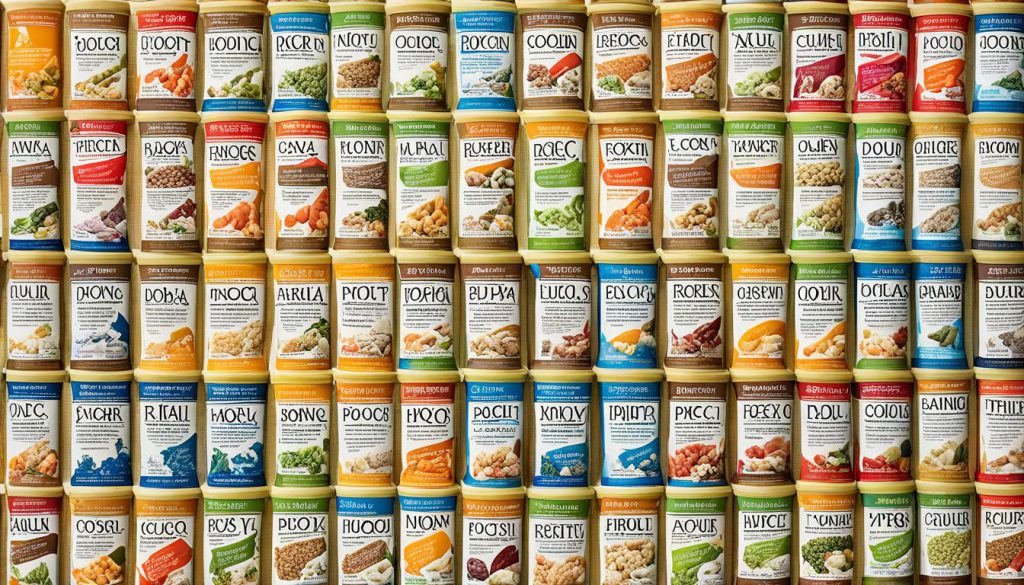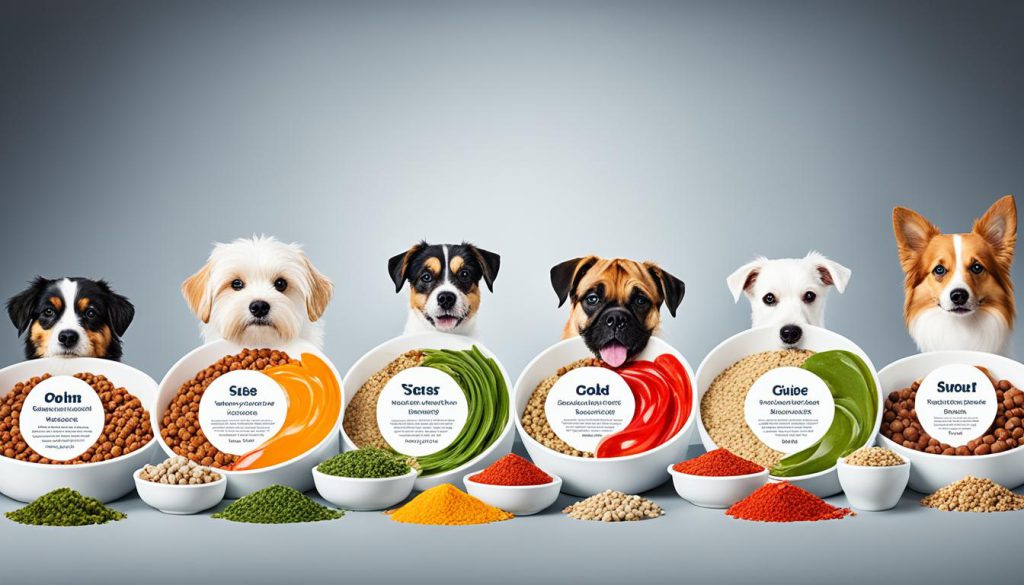Did you know that dogs, part of the Carnivora order, are not just meat-eaters? They are omnivorous. This means they need plant and animal foods to stay healthy. Knowing this helps in providing optimal nutrition for your dog’s health.
A dog’s diet must have quality proteins, fats, minerals, and vitamins. It should also include essential amino acids and fatty acids. These needs change as dogs age, from puppy to senior phases. While many think dogs need only meat, they can also process carbohydrates. This is because their digestive system has enzymes that break down cooked carbohydrates.
It’s important to choose dog food that meets the AAFCO guidelines. These guidelines help make sure the dog food is complete and supports good health.
Key Takeaways
- Dogs are omnivorous and can thrive on a diet of both plant and animal origins.
- A well-balanced dog diet includes proteins, fats, minerals, vitamins, essential amino acids, and essential fatty acids.
- Nutritional requirements change with a dog’s life stage, from puppy to senior.
- Carbohydrates are digestible by dogs, especially when cooked.
- Refer to AAFCO guidelines to ensure dog food is complete and balanced.
The Importance of a Balanced Diet for Your Dog
A balanced diet is essential for your dog’s well-being. It meets all their nutritional needs for a healthy, happy life. Understanding the elements of a balanced diet will help your furry friend stay vibrant and lively. We’ll explore the essentials of a balanced diet and the importance of macronutrients and micronutrients.
What is a Balanced Diet?
A balanced diet for dogs includes essential nutrients in the right amounts. It contains proteins, fats, carbohydrates, vitamins, and minerals. The needs depend on the dog’s age, breed, life stage, and health. Following the AAFCO guidelines ensures commercial foods meet these nutritional standards.
The Role of Macronutrients
Macronutrients like proteins, fats, and carbohydrates are major energy sources. Dogs require these in large quantities:
- Proteins: Important for tissue repair, proteins supply essential amino acids. Animal-based proteins are richer in these amino acids than plant-based proteins.
- Fats: Providing energy, fats are key for healthy skin and coats. Omega-3 and omega-6 fatty acids, for example, help in vitamin absorption.
- Carbohydrates: Carbs, especially post-cooking, provide energy and aid digestion. They are also vital for intestinal health.
The Role of Micronutrients
Micronutrients, including vitamins and minerals, support many of a dog’s bodily functions:
- Vitamins: Necessary for vision, immune health, bone strength, and more, vitamins A, C, D, and E are essential.
- Minerals: Dogs need over 18 minerals for their health, with seven required in higher amounts. They support bones and metabolism.
Knowing about a balanced diet helps ensure your dog gets the right nutrients. Always match the diet to your pet’s specific needs and life stage. Choose high-quality ingredients that fit your dog’s requirements for complete daily nutrition.
Essential Nutrients for Dogs: Macronutrients and Micronutrients
Dogs need the right macronutrients and micronutrients to stay healthy. Nutrients play different roles in their diet. They must be balanced for a dog’s nutritional needs.
Proteins
Proteins are essential for repairing body tissues. They are made of amino acids. Dogs get these from their nutrient intake.
AAFCO says dogs need at least 22% DM proteins for growth. For adult dogs, it’s 18% DM. More than 30% DM can be bad.
Protein quality, shown by Biological Value (BV), is key. Animal proteins with high BV are best. They give dogs essential amino acids efficiently. Choosing dog foods with high-BV proteins helps with proper nutrient intake.
Fats
Fats give a lot of energy and keep the skin and coat healthy. The right fats are crucial. They support dog’s health.
Include Omega-3 and Omega-6 fats for a healthy balance.
Carbohydrates
Carbs are key for energy and gut health. They include starches and fibers. Cooked carbs are easier for dogs to digest.
An appropriate amount in dog food ensures a balanced diet.
Vitamins and Minerals
Vitamins and minerals are vital for dogs. They support strong bones and many body functions. For example, calcium and phosphorus are needed for bone health.
Vitamins A, D, E, and K cover various needs. Make sure dog food has these micronutrients. Following AAFCO guidelines guarantees dogs get crucial nutrients.
Meeting Your Dog’s Nutritional Needs
It’s vital to know what your dog needs to eat to stay healthy. Dogs eat both plant and animal foods. They need proteins, fats, carbs, minerals, vitamins, and other nutrients.
Understanding Your Dog’s Daily Nutritional Requirements
What your dog eats every day is key to their health. The Association of American Feed Control Officials (AAFCO) sets rules for pet food. These rules help make sure the food is good and nutritious. The food your dog needs depends on their size, how active they are, and their lifestyle. To figure out how much energy your dog needs, multiply their weight in kg by 30 and add 70.
Stages of Life and Nutritional Needs
As dogs grow, their food needs change. Puppies need lots of proteins and fats to help them grow. Adult dogs need a varied diet to keep them energetic and healthy. Older dogs may need special food for their joints and digestion. Dogs that are pregnant or do a lot of work need more food to keep up.
Talking to a vet can help you find the best food for your dog. They can give advice that fits your pet’s unique needs. This helps make sure your dog is healthy at all times.
How to Choose the Right Dog Food

Choosing the right dog food might seem tough with so many choices out there. But, getting to know dog food labels, looking for top-notch ingredients, and following AAFCO’s rules can help a lot. This ensures your dog gets everything they need from their meals.
Decoding Dog Food Labels
Dog food labels pack in lots of essential info for pet owners. Ingredients are listed by weight, from most to least. That means the first ingredients are what most of the food is made of. It’s best to find foods with things like chicken or beef listed first. Stay away from “meat by-products.” Also, check the guaranteed analysis for details on protein, fat, fiber, and moisture.
Selecting Quality Ingredients
Choosing high-quality ingredients is key for good dog food. Dogs thrive on a diet that includes grains, fruits, and veggies, not just meat. Look for foods that have clear protein sources, such as chicken or salmon. Avoid fillers and fake preservatives. The best dog foods usually have 25%–35% protein. This is more than the AAFCO’s suggested minimums of 18% for grown dogs and 22.5% for puppies.
Understanding AAFCO Guidelines
Checking if dog food follows AAFCO guidelines is essential. These guidelines help make sure dog foods are well-rounded and fit for all life stages. They consider what different dogs need nutritionally. If a food meets these standards, it’s a good sign it will support your dog’s health.
By studying food labels, choosing high-quality foods, and understanding AAFCO’s rules, you can find the best food for your dog. This will help them stay healthy and happy.
The Role of Water in Your Dog’s Diet
Water is vital in a dog’s diet, as it helps with digestion, circulation, and getting rid of waste. Dogs are made up of over half water, showing how important it is. Keeping your dog hydrated is key to prevent dehydration and its dangers.
Dogs eating dry food need more water because it has less moisture. At cooler temperatures below 20°C, they need about 40-50 ml/kg of their body weight. But, as it gets hotter, they may need up to 50-100 ml/kg. For very active dogs, this can go up to 150 ml/kg.
Dogs on a wet food diet don’t need as much water. They only need around 5-10 ml/kg when it’s cool. Once it gets warm, this goes up to 20-50 ml/kg. If they’re active in the heat, they might need 50-100 ml/kg.
To keep dogs hydrated, especially in the heat or during a lot of exercises, watch their water intake. Always offer them fresh, clean water. This meets their daily needs for essential nutrients and their diet.
| Condition | Dry Food Water Requirements (ml/kg) | Wet Food Water Requirements (ml/kg) |
|---|---|---|
| Below 20°C | 40-50 | 5-10 |
| Above 20°C | 50-100 | 20-50 |
| High Activity (Below 20°C) | Up to 100 | Not specified |
| High Activity (Above 20°C) | Up to 150 | 50-100 |
Remember, keeping up with water is a big part of a dog’s diet. Always talk to a vet to make sure your dog gets the right amount of water and nutrition. This helps them stay healthy at every age.
Homemade Dog Food: Pros and Cons
Making dog food at home has gotten popular among pet lovers who want better control over what their dogs eat. It’s vital to look at the good and bad sides of this carefully.
Benefits of Homemade Diets
Homemade dog food lets you pick high-quality ingredients for your pet’s meals. This is especially important for dogs with food allergies. Also, meals made from fresh items can taste better and encourage dogs to eat well, unlike some store-bought foods.
Challenges of Homemade Diets
Even though making your dog’s food gives you control, it’s tough to get the nutrition just right. Not all recipes you find are balanced. There’s no strong proof that homemade food is always healthier than store-bought. Always talk to a vet or a pet nutrition expert when making your dog’s diet to ensure it has everything your pet needs.
Recipes and Nutritional Balance
Following recipes closely is key when preparing homemade dog food. Making changes on your own can lead to too much or too little of certain nutrients, which can harm your dog’s health. Foods like chocolate and grapes are harmful to dogs and should be avoided. Also, making food at home takes a lot of time. Planning meals ahead can make things easier.
Sometimes, you might need to add supplements to your dog’s homemade meals to make sure they’re getting a balanced diet. Switching to homemade food should be done slowly to prevent stomach problems. Some dogs on homemade diets, especially those grain-free or with lots of fiber, have had heart issues. It’s best to work with a vet who knows about pet diets to make sure your dog’s meals are safe and healthy.
Common Dietary Myths About Dogs
Many myths about what dogs should eat often lead pet owners astray. It’s crucial to clear up these misunderstandings. Doing so helps ensure our dogs get the right nutrition for a healthy life.
Myth: Dogs Can’t Digest Carbohydrates
It’s a common but incorrect belief that dogs can’t handle carbs. Although dogs come from a carnivorous background, they’ve evolved. Their bodies can now process cooked starches well. This means carbs are a key energy source for them.
Grains such as rice and oats are more than just digestible carbs. They also provide essential nutrients and fiber. These are important for a dog’s health.
Myth: Raw Diets Are Best
Some think that raw diets are superior for dogs. But this belief overlooks the health risks involved. Studies link raw feeding in dogs to dangers like antibacterial-resistant E. coli. Raw diets can also cause nutrient imbalances and expose pets and owners to harmful bacteria.
A properly balanced cooked diet is often safer and just as good. Ensuring dogs eat complete, nutrient-rich meals is key to their health.
Myth: Dogs Only Need Meat
There’s a myth that dogs should eat mainly meat, labeled as obligate carnivores. But dogs are actually omnivores, which means they need a variety of foods. Their diet should include proteins, fats, and carbohydrates for complete nutrition.
While meat is important for protein, dogs also need plant-based nutrients. Foods like vegetables help keep them healthy overall. This balance is essential for their diet.
Special Dietary Considerations for Specific Breeds
Every dog breed has unique nutritional needs and dietary considerations. It’s crucial for their best health. While all dogs need a mix of proteins, fats, carbs, vitamins, and minerals, certain breeds have specific requirements. These needs are due to their genetics, metabolism, and how active they are.

Breed-specific diets matter a lot for breeds like Labradors, known to easily gain weight. Their diets often have fewer calories. This helps keep their weight in check. Some food even comes in big, donut shapes to make Labradors eat slower, which is better for their digestion.
Then, there are the active breeds like Border Collies or German Shepherds. They need lots of energy. Their food should have more protein and fat. These nutrients meet their activity needs. Their food must also meet the AAFCO’s minimum nutrient requirements for a balanced diet.
Some breeds face certain health risks. For instance, Dalmatians can get urinary stones. They may need food that’s high in moisture and has special minerals. This can help keep their urinary health okay. Miniature Schnauzers might have to eat less fat due to their risk of high cholesterol.
It’s also key to get the nutrient balance right at different life stages. Puppies, especially those from big breeds, need the right amount of calcium and phosphorus. This helps their bones develop well without causing problems.
Talking to a vet or a vet nutritionist can be really helpful. They can make a diet plan that suits your dog’s own nutritional needs. By considering your dog’s breed and health, and following AAFCO guidelines, your pet can live a healthy life.
Tips for Feeding and Meal Scheduling
Keeping your dog healthy involves effective feeding and scheduling meals. By managing how much and how often your dog eats, you can give them a balanced diet full of needed nutrients. This is key for their overall well-being.
Determining Portion Sizes
Finding the right amount of food for your dog can be tough. You need to consider their size, age, and how active they are. Start with the recommendations from the dog food package, but adjust as needed. Always good to check with a vet for advice tailored to your dog.
Feeding Frequency
How often your dog eats is also important for their health. Puppies need to eat more often than adult dogs to fuel their growth and energy. For adults, two meals a day usually works well. Eating regularly helps keep their metabolism steady and avoids overeating. Splitting the total daily food into several smaller meals can help control hunger.
Avoiding Overfeeding
It’s important to prevent your dog from becoming overweight, which can lead to health issues. Watch their weight and shape to keep their diet balanced. Tempting as it may be, too many treats or table scraps can upset this balance and cause weight gain. Stick to regular meal times and measure how much they eat.
- Quick takeout meals chosen due to busy schedules can contribute to expanding waistlines.
- Meal planning can save money, time, aid in weight control, and ensure a balanced diet.
- Proper storage practices are essential for successful meal planning.
- Monitoring weight and adjusting portion sizes helps avoid overfeeding.
Conclusion
Making sure your dog eats right is very important for its health and happiness. It’s key to give them food that matches their needs, based on their age, health, and how active they are. Learning about what’s in dog food, keeping them hydrated, and avoiding food myths will help your dog stay healthy.
Dog nutrition is more than just their meals. It includes proper meal sizes, enough water, and understanding how their needs change with activity and weather. For example, dogs need more water but less food in hot weather. This is because they move less but lose more water through panting.
Talking to a vet or a dog food expert is a smart move. They can guide you to the best food choices for your dog. Their advice can lead to a longer, happier life for your dog. By focusing on good nutrition, you’re making sure your dog has a great life.
Source Links
- https://vcahospitals.com/know-your-pet/nutrition-general-feeding-guidelines-for-dogs
- https://www.petmd.com/dog/nutrition/evr_dg_whats_in_a_balanced_dog_food
- https://www.nomnomnow.com/learn/article/what-does-a-balanced-diet-for-dogs-include
- https://www.akc.org/expert-advice/nutrition/choosing-right-dog-food/
- https://www.petmd.com/dog/nutrition/how-to-choose-the-best-dog-food
- https://www.animalhumanesociety.org/resource/choosing-right-food-your-dog-or-cat
- https://europeanpetfood.org/pet-food-facts/fact-sheets/nutrition/the-importance-of-water-in-your-pets-diet/
- https://www.petfoodinstitute.org/blog/nutritional-value-water/
- https://www.petmd.com/dog/nutrition/how-make-sure-your-homemade-dog-food-delivers-right-nutrients
- https://www.akc.org/expert-advice/nutrition/cooking-for-your-dog-dos-and-donts/
- https://www.akc.org/expert-advice/nutrition/dog-food-myths/
- https://petwaste.com/tips-for-dog-owners/canine-nutrition-myths-busted-separating-fact-from-fiction-in-feeding-your-dog/
- https://www.metrovetchicago.com/services/dogs/blog/debunking-5-common-dog-nutrition-myths-keep-your-canine-healthy-possible
- https://vetnutrition.tufts.edu/2018/08/breed-specific-diets/
- https://www.hsph.harvard.edu/nutritionsource/meal-prep/
- https://www.nia.nih.gov/health/healthy-eating-nutrition-and-diet/healthy-meal-planning-tips-older-adults
- https://www.eatright.org/food/planning/smart-shopping/3-strategies-for-successful-meal-planning
- https://www.ncbi.nlm.nih.gov/books/NBK236234/
- https://www.ncbi.nlm.nih.gov/books/NBK234770/
- https://nap.nationalacademies.org/read/1222/chapter/32

